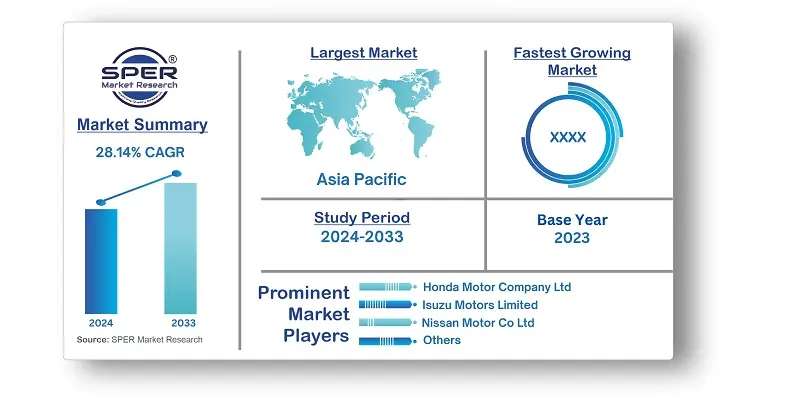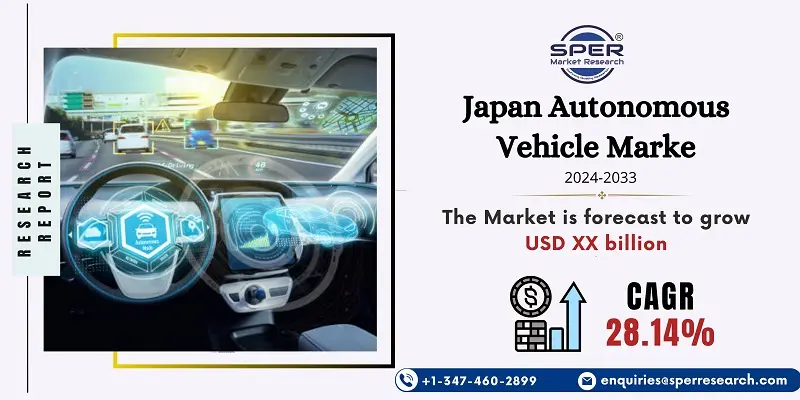
Japan Autonomous Vehicle Market Growth, Size, Trends, Share, Competition and Future Outlook
Japan Autonomous Vehicle Market Size- By Vehicle Type, By Automation Type, By Propulsion- Regional Outlook, Competitive Strategies and Segment Forecast to 2033
| Published: Sep-2024 | Report ID: AMIN24200 | Pages: 1 - 109 | Formats*: |
| Category : Automotive & Transportation | |||
- June 2022; Isuzu Motors announced a collaboration with a technology firm to build self-driving trucks for logistics.
- November 2022; Nissan began testing its Level 4 autonomous vehicles on Tokyo's public highways.
- December 2023; Honda unveiled its autonomous car, which includes sophisticated Lidar and radar sensors.
- March 2024; Toyota established a cooperation with a top technology to improve its self-driving software.


| Report Metric | Details |
| Market size available for years | 2020-2033 |
| Base year considered | 2023 |
| Forecast period | 2024-2033 |
| Segments covered | By Vehicle Type, By Automation Type, By Propulsion |
| Regions covered | Tohoku, Kanto, Chubu, Kansai, Chugoku, Shikoku, Kyushu |
| Companies Covered | Honda Motor Company Ltd, Isuzu Motors Limited, Nissan Motor Co Ltd, Toyota Motor Corporation, Ud Trucks Corporation. |
- Automotive Manufacturers
- Technology Companies
- Government and Regulatory Bodies
- Logistics and Delivery Companies
- Public Transportation Authorities
- Fleet Operators and Taxi Services
- Consumers
| By Vehicle Type: |
|
| By Automation Type: |
|
| By Propulsion: |
|
- Japan Autonomous Vehicle Market Size (FY’2024-FY’2033)
- Overview of Japan Autonomous Vehicle Market
- Segmentation of Japan Autonomous Vehicle Market by Vehicle Type (Passenger Car, Commercial Vehicle)
- Segmentation of Japan Autonomous Vehicle Market by Automation Type (Semi-Autonomous, Fully- Autonomous)
- Segmentation of Japan Autonomous Vehicle Market by Propulsion (ICE, Electric)
- Statistical Snap of Japan Autonomous Vehicle Market
- Expansion Analysis of Japan Autonomous Vehicle Market
- Problems and Obstacles in Japan Autonomous Vehicle Market
- Competitive Landscape in the Japan Autonomous Vehicle Market
- Impact of COVID-19 and Demonetization on Japan Autonomous Vehicle Market
- Details on Current Investment in Japan Autonomous Vehicle Market
- Competitive Analysis of Japan Autonomous Vehicle Market
- Prominent Players in the Japan Autonomous Vehicle Market
- SWOT Analysis of Japan Autonomous Vehicle Market
- Japan Autonomous Vehicle Market Future Outlook and Projections (FY’2024-FY’2033)
- Recommendations from Analyst
1.1. Scope of the report1.2. Market segment analysis
2.1. Research data source2.1.1. Secondary Data2.1.2. Primary Data2.1.3. SPER’s internal database2.1.4. Premium insight from KOL’s2.2. Market size estimation2.2.1. Top-down and Bottom-up approach2.3. Data triangulation
4.1. Driver, Restraint, Opportunity and Challenges analysis4.1.1. Drivers4.1.2. Restraints4.1.3. Opportunities4.1.4. Challenges4.2. COVID-19 Impacts of the Japan Autonomous Vehicle Market.
5.1. SWOT Analysis5.1.1. Strengths5.1.2. Weaknesses5.1.3. Opportunities5.1.4. Threats5.2. PESTEL Analysis5.2.1. Political Landscape5.2.2. Economic Landscape5.2.3. Social Landscape5.2.4. Technological Landscape5.2.5. Environmental Landscape5.2.6. Legal Landscape5.3. PORTER’s Five Forces5.3.1. Bargaining power of suppliers5.3.2. Bargaining power of buyers5.3.3. Threat of Substitute5.3.4. Threat of new entrant5.3.5. Competitive rivalry5.4. Heat Map Analysis
6.1. Japan Autonomous Vehicle Market Manufacturing Base Distribution, Sales Area, Product Type6.2. Mergers & Acquisitions, Partnerships, Product Launch, and Collaboration in Japan Autonomous Vehicle Market
7.1. Japan Autonomous Vehicle Market Size, Share and Forecast, By Vehicle Type, 2020-20267.2. Japan Autonomous Vehicle Market, Share and Forecast, By Vehicle Type, 2027-20337.3. Passenger Car7.4. Commercial Vehicle
8.1. Japan Autonomous Vehicle Market, Share and Forecast, By Automation Type, 2020-20268.2. Japan Autonomous Vehicle Market Size, Share and Forecast, By Automation Type, 2027-20338.3. Semi-Autonomous8.4. Fully-Autonomous
9.1. Japan Autonomous Vehicle Market Size, Share and Forecast, By Propulsion, 2020-20269.2. Japan Autonomous Vehicle Market Size, Share and Forecast, By Propulsion, 2027-20339.3. ICE9.4. Electric
10.1. Japan Autonomous Vehicle Market Size and Market Share
11.1. Japan Autonomous Vehicle Market Size and Market Share By Region (2020-2026)11.2. Japan Autonomous Vehicle Market Size and Market Share By Region (2027-2033)11.3. Tohoku11.4. Kanto11.5. Chubu11.6. Kansai11.7. Chugoku11.8. Shikoku11.9. Kyushu
12.1. HONDA MOTOR COMPANY LTD12.1.1. Company details12.1.2. Financial outlook12.1.3. Product summary12.1.4. Recent developments12.2. ISUZU MOTORS LIMITED12.2.1. Company details12.2.2. Financial outlook12.2.3. Product summary12.2.4. Recent developments12.3. NISSAN MOTOR CO LTD12.3.1. Company details12.3.2. Financial outlook12.3.3. Product summary12.3.4. Recent developments12.4. TOYOTA MOTOR CORPORATION12.4.1. Company details12.4.2. Financial outlook12.4.3. Product summary12.4.4. Recent developments12.5. UD TRUCKS CORPORATION12.5.1. Company details12.5.2. Financial outlook12.5.3. Product summary12.5.4. Recent developments
12.6. Others
SPER Market Research’s methodology uses great emphasis on primary research to ensure that the market intelligence insights are up to date, reliable and accurate. Primary interviews are done with players involved in each phase of a supply chain to analyze the market forecasting. The secondary research method is used to help you fully understand how the future markets and the spending patterns look likes.
The report is based on in-depth qualitative and quantitative analysis of the Product Market. The quantitative analysis involves the application of various projection and sampling techniques. The qualitative analysis involves primary interviews, surveys, and vendor briefings. The data gathered as a result of these processes are validated through experts opinion. Our research methodology entails an ideal mixture of primary and secondary initiatives.



Frequently Asked Questions About This Report
PLACE AN ORDER
Year End Discount
Sample Report
Pre-Purchase Inquiry
NEED CUSTOMIZATION?
Request CustomizationCALL OR EMAIL US
100% Secure Payment






Related Reports
Our Global Clients
Our data-driven insights have influenced the strategy of 200+ reputed companies across the globe.






















